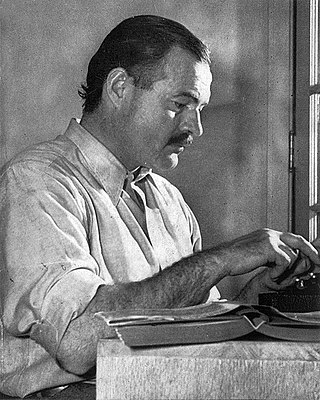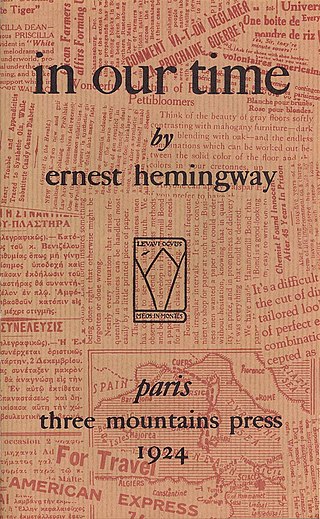
Ernest Miller Hemingway was an American novelist, short-story writer and journalist. Known for an economical, understated style that influenced later 20th-century writers, he has been romanticized for his adventurous lifestyle and outspoken, blunt public image. Some of his seven novels, six short-story collections and two non-fiction works have become classics of American literature, and he was awarded the 1954 Nobel Prize in Literature.

A Night to Remember is a 1955 non-fiction book by Walter Lord that depicts the sinking of the RMS Titanic on 15 April 1912. The book was hugely successful, and is still considered a definitive resource about the Titanic. Lord interviewed 63 survivors of the disaster and drew on books, memoirs, and articles that they had written. In 1986, Lord authored his follow-up book, The Night Lives On, following renewed interest in the story after the wreck of the Titanic was discovered by Robert Ballard.

Wallace Stevens was an American modernist poet. He was born in Reading, Pennsylvania, educated at Harvard and then New York Law School, and spent most of his life working as an executive for an insurance company in Hartford, Connecticut.

Blind Harry, also known as Harry, Hary or Henry the Minstrel, is renowned as the author of The Actes and Deidis of the Illustre and Vallyeant Campioun Schir William Wallace, more commonly known as The Wallace. This is a lengthy poem recounting the life of William Wallace, the Scottish independence leader, written around 1477, 172 years after Wallace's death.

Annie Dillard is an American author, best known for her narrative prose in both fiction and non-fiction. She has published works of poetry, essays, prose, and literary criticism, as well as two novels and one memoir. Her 1974 book Pilgrim at Tinker Creek won the 1975 Pulitzer Prize for General Nonfiction. From 1980, Dillard taught for 21 years in the English department of Wesleyan University, in Middletown, Connecticut.
In publishing, a note is a brief text wherein the author comments upon the subject and themes of the book and names the supporting citations. In the editorial production of books and documents, typographically, a note is usually several lines of text at the bottom of the page, at the end of a chapter, at the end of a volume, or a house-style typographic usage throughout the text. Notes are usually identified with superscript numbers or a symbol.

The Sun Also Rises is the first novel by the American writer Ernest Hemingway. It portrays American and British expatriates who travel from Paris to the Festival of San Fermín in Pamplona and watch the running of the bulls and the bullfights. An early modernist novel, it received mixed reviews upon publication. Hemingway biographer Jeffrey Meyers writes that it is now "recognized as Hemingway's greatest work" and Hemingway scholar Linda Wagner-Martin calls it his most important novel. The novel was published in the United States in October 1926 by Scribner's. A year later, Jonathan Cape published the novel in London under the title Fiesta. It remains in print.

Raymond Radiguet was a French novelist and poet whose two novels were noted for their explicit themes, and unique style and tone.

To Have and Have Not is a novel by Ernest Hemingway published in 1937 by Charles Scribner's Sons. The book follows Harry Morgan, a fishing boat captain out of Key West, Florida. To Have and Have Not was Hemingway's second novel set in the United States, after The Torrents of Spring.

In Our Time is the title of Ernest Hemingway's first collection of short stories, published in 1925 by Boni & Liveright, New York, and of a collection of vignettes published in 1924 in France titled in our time. Its title is derived from the English Book of Common Prayer, "Give peace in our time, O Lord".

Across the River and Into the Trees is a novel by American writer Ernest Hemingway, published by Charles Scribner's Sons in 1950, after first being serialized in Cosmopolitan magazine earlier that year. The title is derived from the last words of U.S. Civil War Confederate General Thomas J. "Stonewall" Jackson: “Let us cross over the river and rest under the shade of the trees.”
Show, don't tell is a narrative technique used in various kinds of texts to allow the reader to experience the story through actions, words, subtext, thoughts, senses, and feelings rather than through the author's exposition, summarization, and description. It avoids adjectives describing the author's analysis and instead describes the scene in such a way that readers can draw their own conclusions. The technique applies equally to nonfiction and all forms of fiction, literature including haiku and Imagist poetry in particular, speech, movie making, and playwriting.
A vignette is a French loanword expressing a short and descriptive piece of writing that captures a brief period in time. Vignettes are more focused on vivid imagery and meaning rather than plot. Vignettes can be stand-alone, but they are more commonly part of a larger narrative, such as vignettes found in novels or collections of short stories.

The Lone Ranger and Tonto Fistfight in Heaven is a 1993 collection of interconnected short stories by Sherman Alexie. The characters and stories in the book, particularly "This Is What It Means to Say Phoenix, Arizona", provided the basis of Alexie's screenplay for the film Smoke Signals.
"The Idea of Order at Key West" is a poem written in 1934 by modernist poet Wallace Stevens. It is one of many poems included in his book, Ideas of Order. It was also included in The Collected Poems of Wallace Stevens for which he won the Pulitzer Prize for Poetry.
Epic is a narrative genre characterised by its length, scope, and subject matter. The defining characteristics of the genre are mostly derived from its roots in ancient poetry. An epic is not limited to the traditional medium of oral poetry, but has expanded to include modern mediums including film, theater, television shows, novels, and video games.
The term Bible fiction refers to works of fiction which use characters, settings and events taken from the Bible. The degree of fictionalization in these works varies and, although they are often written by Christians or Jews, this is not always the case.
Edward Steinhardt is an American poet, journalist, editor and fiction author.

"My Old Man" is a short story written by Ernest Hemingway, published in his 1923 book Three Stories and Ten Poems, which published by a small Paris imprint. The story was also included in his next collection of stories, In Our Time, published in New York in 1925 by Boni & Liveright. The story tells of a boy named Joe whose father is a steeplechase jockey, and is narrated from Joe's point-of-view.

"Out of Season" is a short story written by Ernest Hemingway, first published in 1923 in Paris in the privately printed book, Three Stories and Ten Poems. It was included in his next collection of stories, In Our Time, published in New York in 1925 by Boni & Liveright. Set in Cortina d'Ampezzo, Italy, the story is about an expatriate American husband and wife who spend the day fishing, with a local guide. Critical attention focuses chiefly on its autobiographical elements and on Hemingway's claim that it was his first attempt at using the "theory of omission".












